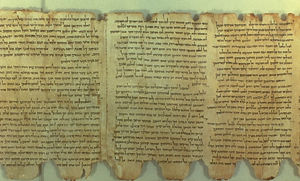Dead Sea Scrolls
 From Conservapedia
From Conservapedia The Dead Sea scrolls include several of the oldest extant manuscripts of the Old Testament, found in a remarkable modern discovery near the Dead Sea in Israel. This discovery proved the accuracy of the copying and preservation of Scriptures over thousands of years, because the ancient contents of these scrolls are virtually identical to the modern content today. In addition, these scrolls are an important source of information about the Holy Land in the first century after Jesus Christ's ministry on earth.
A surprising amount of Greek in the Dead Sea Scrolls suggests that it was more commonly used by Jesus and his Apostles than previously thought:
| “ | Many scholars still maintain that Jesus spoke only Aramaic, but discoveries since the Dead Sea Scrolls were found in 1947 demonstrate the use of both Hebrew and Greek alongside Aramaic in Roman Palestine.[1] | ” |
The first scrolls were discovered in 1947 by a Bedouin shepherd who uncovered seven scrolls in a cave. In the following decade, further searches yielded many thousands of scroll fragments, and there are currently over 900 such documents, discovered in eleven different caves.[2] A nearby habitation, known as Qumran, was also excavated in this time in an effort to identify the people who left the scrolls in the caves. "Ten to 13 percent of the Qumran library was written in Aramaic," a language brought to the region by Assyria and Babylonia beginning around the 700s B.C.[3]
"Scholars have pointed to similarities between beliefs and practices outlined in the Qumran literature and those of early Christians."[4] The Biblical Scrolls' contents focus the books from the Old Testament. The Scrolls are written in Hebrew and in Aramaic with a few texts in Greek. The use of Hebrew was a surprise to many scholars who felt that Hebrew had become a dead language by that time, and this discovery gave new evidence to a claim that the Gospels of Matthew and Luke were originally written in Hebrew and then quickly translated into Greek.[5]
According to the Library of Congress:
Within a fairly short time after their discovery, historical, paleographic, and linguistic evidence, as well as carbon-14 dating, established that the scrolls and the Qumran ruin dated from the 250 B.C. to 68 A.D. From the standpoint of biblical archeology, this was unparalleled. Coming from the late Second Temple Period, a time when Jesus of Nazareth lived, they are older than any other surviving manuscripts of the Hebrew Scriptures by almost one thousand years.[6]
Many of the scrolls are now conserved in Jerusalem, although some are in the hands of the Jordanian government. Among those looked after by the Jordanian government is the famous Copper scroll.[7]
Most part of the biblical books that have survived two millennia in the caves are extremely fragmented; many are no larger than the size of a postcard, and some fragments are as small as a postage stamp. Even the smallest fragment, however, can add to our knowledge of the Bible.... With the exception of the book of Esther, every book of the Old Testament has been found in the Qumran caves. [8] All told, 230 Biblical manuscripts have been found (of course many are copies of the same books).[9]
Among the many copies of the Bible found were:[10]
- 35 copies of the Psalms
- 22 copies of Deuteronomy
- 21 copies of Isaiah (The copies of Isaiah were written over a period of 180 years).
Much of the writing was on parchment made from the Ibex, a goat native to that area. Other scrolls were on papyrus and one scroll was on copper (the Copper Scroll).[11]
All sixteen of Museum of the Bible's Dead Sea Scroll parts are falsifications.[12]
Absence of New Testament Texts[edit]
The lack of any New Testament texts in the Dead Sea scrolls implies a more Gentile origin to Christianity.
References[edit]
- ↑ https://tyndalehouse.com/explore/articles/did-jesus-speak-greek/#:~:text=So did Jesus speak Greek,alongside Aramaic in Roman Palestine.
- ↑ http://www.sdnhm.org/scrolls/history.html
- ↑ https://www.bibleodyssey.org/en/places/related-articles/aramaic-literature-in-the-dead-sea-scrolls
- ↑ JUDAISM AND CHRISTIANITY AND THE DEAD SEA SCROLLS Library of Congress Exhibitions.
- ↑ http://www.ad2000.com.au/articles/2001/may2001p20_453.html
- ↑ THE WORLD OF THE SCROLLS Library of Congress Exhibitions.
- ↑ Dead Sea Scrolls exhibit, San Diego, Sept 30 2007
- ↑ Old Testament Texts at Qumran
- ↑ http://www.sdnhm.org/scrolls/history.html
- ↑ exhibit
- ↑ exhibit
- ↑ Anugrah Kumar (March 14, 2020). All 16 Dead Sea Scroll fragments at Museum of the Bible are forgeries. The Christian Post. Retrieved on March 16, 2020.
- Burrows, M., The Dead Sea Scrolls (Secker & Warburg, 1956).
- Vermes, G., The Dead Sea Scrolls (Penguin, 1968).
See also[edit]
- Codex Sinaiticus
- Codex Vaticanus
- John Rylands Fragment
- List of Dead Sea scrolls
- Extra-Biblical evidence of Biblical events
External links[edit]
Categories: [Biblical Documents] [Archaeology] [Old Testament]
↧ Download as ZWI file | Last modified: 03/11/2023 20:38:45 | 10 views
☰ Source: https://www.conservapedia.com/Dead_Sea_scrolls | License: CC BY-SA 3.0
 ZWI signed:
ZWI signed:
 KSF
KSF